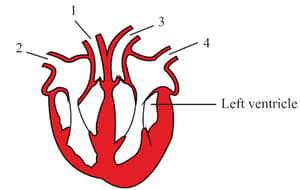Transportation
Transportation: Overview
This topic explains how the circulatory system helps the movement of gases, blood and other required nutrients from one part of the body to another. In humans, it is performed by blood vessels, while in plants it is performed by vascular tissues.
Important Questions on Transportation
Moss plants do not grow to greater heights. Why?
_____ (AV Node/SA Node) is the reserved pacemaker.
Assertion: RBC plays an important role in the transport of respiratory gases.
Reason: RBC does not have cell organelles and nucleus.
The below diagram shows a vertical section through the heart.

Identify the functions of the numbered blood vessels.
| Carries blood to body | Carries blood to lungs | Carries blood from lungs | Carries blood from body | |
| (A) | 1 | 2 | 3 | 4 |
| (B) | 1 | 3 | 4 | 2 |
| (C) | 2 | 4 | 3 | 1 |
| (D) | 3 | 1 | 4 | 2 |
All the reptiles have a three-chambered heart.
Which of the following animals possess a heart with two atria and a partially divided ventricle?
Fill in the blank with the correct answer from the bracket.
Most of the reptiles have a _____ chambered heart. (two, three, four)
Phloem cell wall is composed of _____ (lignin/cellulose).
Xylem has a thick wall, having parenchyma as only living cell.
Which one of the following is correct for xylem and phloem?
Write one difference between the transportation through the xylem and phloem.
Companion cells facilitate loading of sucrose into sieve elements.
Sieve elements are living cells that conduct the starch in vascular plants.
Mature sieve elements lack _____ (nucleus/mitochondria).
'X' have valves that allow blood to flow only in one direction. These also have wide lumen. 'Y' do not have valves. Name the blood vessel 'X'.
Activated partial _____ time is the test to detect cause of excess bleeding or lack of clotting of blood.
What type of blood vessels carry blood away from the heart?
Fill in the blank with the options provided in the bracket.
The right side of the heart contains _____ (pure, oxygenated, deoxygenated) blood.
Give reasons for the following statements.
Mature RBC in mammals does not have cell organelles.
What are the different types of blood vessels? Explain with the help of a diagram.
